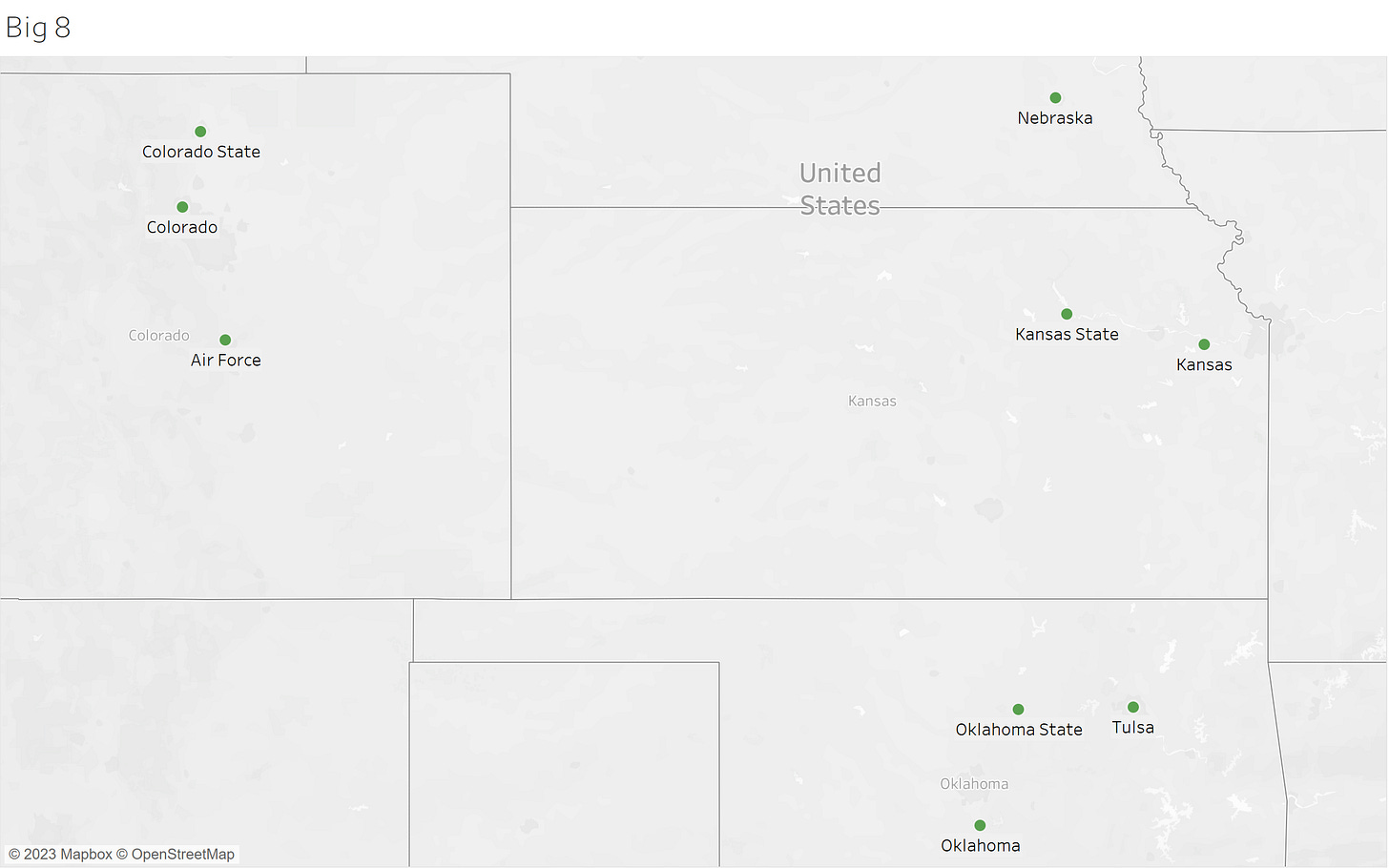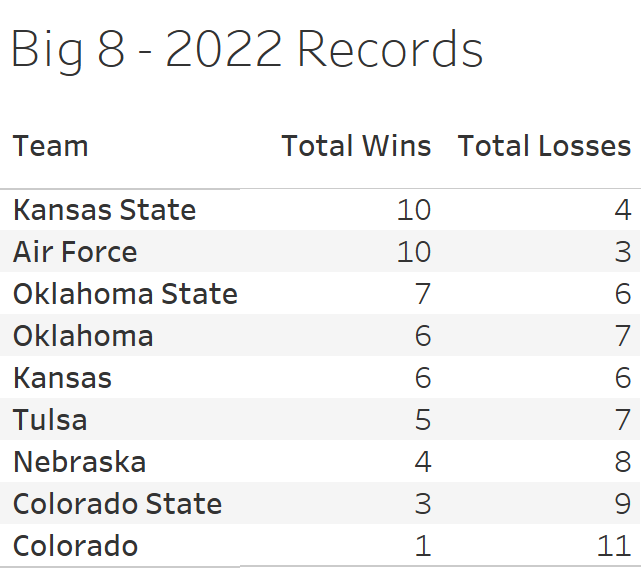Realignment West of the Mississippi River, Part 4
This installment of the realignment series consolidates Texas, reimagines a great old conference, and makes sense of the West Coast.
If you missed any of the previous articles in this series, you can access them here, here, and here. Without further ado, let’s make sense of the western United States.
The Big 8
Out of the eight teams in the original Big 8 when it merged with four teams from the Southwest Conference, six would be in this reformulated Big 8. Only Iowa St. and Missouri would be in other conferences. Discerning readers will notice that there is a Big 8 and a Big 10, both of which have nine teams. What can I say? Historical branding just seemed the way to go.
Oklahoma is the only modern blue blood school in this conference. Under Tom Osborne, Nebraska was consistently ranked among the elites in college football, but the program has been pretty pedestrian for the last two decades. In fact, since 1998, Nebraska has only the 4th best winning percentage in the conference.
Compare that to the Osborne years (1973-1997), when Nebraska finished in the Top 15 of the final Associated Press poll in 24 out of 25 seasons. During that time, the team was ranked in the Top 25 in 304 out of 307 games, including every game from mid-1981 until Osborne retired following the 1997 season. That year, the Huskers split the national title with Michigan. They have only won 60% of their games since then.
In 2022, the conference likely would have come down to the Air Force vs. Kansas St. game. How cool would it be to see a service academy in the playoff?
Of course, 1-11 Colorado hired Deion Sanders in the offseason, and Coach Prime has wasted little time upgrading the talent level in Boulder. College football is more fun when Colorado is good, so hopefully he gets the Buffalos going.
Texas
Yup, that’s it. No fancy title needed. Rice gets the final nod due to its proximity to the University of Houston. Historically, this conference is rooted in the old Southwest Conference, and while I considered restoring that name, there was a lot of negativity around how that league broke up back in the 1990s. It was less of a merger on this side than a crack up, with the four strongest teams joining the Big 8 teams to form the Big 12. The rest of the teams basically scattered in the wind.
UT San Antonio has emerged in recent years as a viable program and one meriting inclusion in this conference.
TCU still feels like a newcomer to the national stage, but as their record demonstrates, they have won at a consistently high level for the last 25 years. A level higher, in fact, than mighty Texas. (This table must be irksome in Austin.)
There is a lot of parity in Texas these days, and one need not work hard to imagine a scenario in which any of the top seven teams wins the conference. National runners-up, TCU, would have been the clear favorites to win the conference in 2022. UT-San Antonio’s 11 wins in 2022 made for two teams in the conference with at least 10 wins.
Southwest
The name here might be controversial, but the grouping of schools seems pretty clear cut. On the name - bringing back a Texas-based Southwest conference felt like a step backward, but I like geography-based names. Stressing the hyperlocal nature of this proposed realignment is all part of the branding. One hundred years ago Texas might have felt like the southwest corner of the country, but in actuality it’s right in the middle of the two coasts. The real southwest is Southern California and Arizona. So, think of this conference in the same terms that you would the current Big East basketball conference.
USC is by far the strongest program in the conference, but most of the other schools have had their moments at some point over the last 25 years. So, while it is probably safe to say that USC could be expected to secure a plurality of conference championships in any ten-year period, an outright majority would be a surprise.
That said, the Trojans, though a bit too defense-optional to crack the ranks of the true elite in 2022, likely would have won the conference last year. One gets the sense that this conference would go as Fresno St. and UCLA do - when they are good, the conference will be good. Arizona St. has a ton of untapped potential - maybe in the NIL era they will finally figure things out.
Northwest
For shear competition, the Northwest is difficult to beat. The conference includes the northern-most schools in the current Pac-12 as well as many schools that at one time or another enjoyed great success in the Mountain West Conference. A lot of these states are sparsely populated, but the people who do live up in this corner of the country care about their football.
And they should get good matchups week after week. In the last 25 years, Boise St. has won 80% of its games. And it still has virtually no chance of making the playoff under the current setup, and only a limited opportunity once the playoff field expands to 12 teams. That’s a crime! The Northwest conference would remedy that situation, but in exchange the Broncos would have to beat a lot of good teams to secure the automatic bid.
Oregon has won at a nearly 73% clip since 1998, while Utah’s winning percentage during that same time period is north of 67%. In terms of winning percentage over the last 25 years, Utah is basically Penn St. And they are only the third best team in this conference. Let that sink in.
This conference would have been SEC West-level good in 2022, with four 10-win teams and Boise St. sitting in the middle of the pack with 9 wins.
Before this exercise, I could not imagine a conference in which a seven-win P5 team would be picked to finish in a tie for 7th place. And there is something else worthy of mention - this conference, with so many good teams capable of winning the title, also features some really interesting home field advantages. Imagine a team like Florida flying into Boise or Pullman for a playoff game in early December. That would be wild!
The Takeaway
Hopefully the series thus far has demonstrated both the viability and the advantages of moving college sports to a hyperlocal model. I am a firm believer that such a realignment is inevitable. No business model can support bi-coastal conferences. Eventually, people are going to stop paying. In fact, I think that Rubicon has already been crossed by players like the Gies College of Business at the University of Illinois (where I earned an MBA completely online for a total cost of $22k while continuing to work full-time) or University of the People, which offers tuition free bachelor’s and master’s programs that charge a miniscule flat rate fee ($120 per undergrad course) for credit seeking students. It’s time to get back to basics, to make college football matter close to home, and to rein in the crazy spending by athletic departments. Only when the cost of being an actively participating fan decreases, and the importance in the community of each game increases, will college sports truly achieve sustainability in the modern marketplace.
















